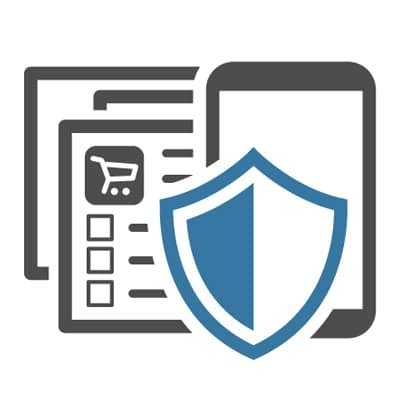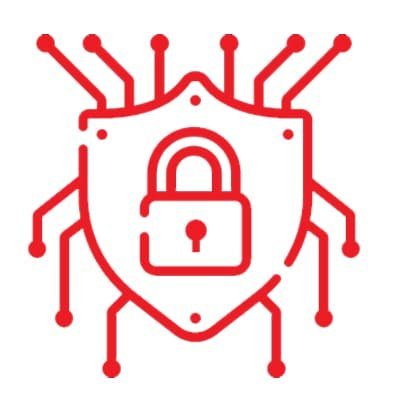
Cybersecurity is an area of focus that is in high demand. So much of our everyday activities are centered online, so having appropriate cybersecurity is vital. When planning for your future, becoming a Certified Information Systems Security Professional (CISSP) is a great route to take. By acquiring this certification and learning about the CISSP exam domains, not only will you be able to take care of your own security needs online, but you’ll also be able to serve others.
Having the ability to extend your skills to others and engage in countless employment opportunities can result in a lucrative income!
Why Would I Want to Become a CISSP?

The shift to an online-centric world has opened new avenues for cyber threats. The sheer volume of data generated daily by individuals and organizations has made it critical to protect sensitive information. As more businesses move online, they face escalating cybersecurity threats ranging from data breaches to identity theft, emphasizing the need for robust security measures.
Becoming a CISSP equips you with the knowledge and skills to safeguard this information. By mastering various cybersecurity principles and practices, you’ll not only enhance your own security but also help others achieve peace of mind.
Job Security and Lucrative Income
With an increasing focus on cybersecurity, job security in this field is robust. The average salary for a CISSP holder in the United States is around $135,510 per year, with many professionals earning even more as they gain experience. Positions available for CISSP-certified professionals range from roles in small startups to major corporations and governmental agencies.
Additionally, CISSP certification opens the door to various career paths. Whether you aspire to be a security consultant, work in a corporate security role, or start your own cybersecurity business, the options are plentiful.
Diverse Career Opportunities
A CISSP certification not only enhances your employability but also offers pathways for career advancement. Here are just a few roles that you might pursue:
- Security Consultant: Advising businesses on best practices for securing their networks and data.
- Chief Information Security Officer (CISO): Leading an organization’s information security strategy.
- Security Analyst: Monitoring networks for security breaches and responding to incidents.
- Security Architect: Designing secure networks and systems to protect sensitive information.
The skills you acquire as a CISSP professional will be in demand across multiple industries, including finance, healthcare, technology, and government.
How Do I Become CISSP Certified?
So, you’re considering the CISSP certification, a globally recognized credential that demonstrates your expertise in cybersecurity. But how exactly do you go about becoming certified?
Step 1: Meet the Eligibility Requirements
Before you can even sit for the CISSP exam, you’ll need to have a minimum of five years of cumulative, paid work experience in at least two of the eight CISSP domains. This experience shows that you have hands-on knowledge and a practical understanding of key security principles. If you don’t yet have five years, don’t worry—if you hold a college degree or an approved certification (like CompTIA Security+), you can reduce this requirement by one year.
Step 2: Prepare for the Exam
The CISSP exam is known for being challenging, as it tests your knowledge across multiple areas of cybersecurity. To succeed, it’s essential to take advantage of structured study resources and practice materials:
- CISSP Prep Courses: A good prep course can be invaluable, covering essential topics in each domain and providing in-depth lessons. Many of these courses offer structured study plans, practice questions, and simulated exams to familiarize you with the format.
- Study Materials: The Official (ISC)² CISSP Study Guide and CISSP All-in-One Exam Guide are popular resources that break down each domain into manageable sections.
- Practice Tests and Simulations: Practice tests are especially useful because they mimic the real exam, which consists of 125–175 multiple-choice and advanced innovative questions. For example, Dooey’s CISSP training course offers simulation exams that help you understand the question types and timing constraints.
- Online Communities and Study Groups: Joining online forums or study groups can give you a support network. Peers can offer valuable insights, answer questions, and share study tips. Platforms like Reddit, LinkedIn, and (ISC)²’s official community are great places to connect with other aspiring CISSPs.
Step 3: Register and Take the Exam
When you’re ready, you’ll register for the exam through the (ISC)² website. The exam itself is computer-based and lasts up to three hours. Testing centers and online proctoring options are available depending on your location and preference.
Step 4: Endorsement and Certification
Once you pass the exam, there’s one more step. You need an endorsement from another (ISC)²-certified professional, confirming that you have the required work experience. After submitting this endorsement, you’ll officially be certified as a CISSP!
What Are CISSP Exam Domains?
There are eight specific areas in cybersecurity, also known as CISSP exam domains, that you should focus on for certification. These CiSSP exam domains focus on different aspects of the cybersecurity world. Each domain is covered in the certification exam and will need to be studied thoroughly.
Without further ado, here are the top eight CiSSP exam domains:
1. Security and Risk Management
Security and Risk Management is the foundational domain in the CISSP certification because it sets the stage for all security practices within an organization. This domain addresses how to identify, assess, and mitigate risks that could jeopardize an organization’s information security. Security professionals in this area establish policies and practices that protect information assets, maintain business continuity, and comply with legal and regulatory obligations. This involves more than just technical solutions; it encompasses building a security-conscious culture, understanding legal requirements, and managing risks effectively.
In this domain, you’ll delve into:
|
|
2. Asset Security
Asset Security deals with the proper handling and protection of an organization’s assets, especially data. Assets include not just physical equipment but digital information, intellectual property, and other resources critical to business operations. This domain teaches security professionals how to classify, handle, and protect data according to its sensitivity, ensuring it remains secure throughout its lifecycle. Effective asset management is crucial to prevent unauthorized access and data breaches, making this domain highly relevant for all security roles.
Key areas of focus within Asset Security include:
|
|
3. Security Architecture and Engineering
Security Architecture and Engineering involve designing, implementing, and managing secure systems. This domain provides insights into creating secure infrastructures, using well-established principles, and adhering to standards that support security objectives. Professionals in this field must understand secure design concepts and various security models that guide system behavior. This knowledge helps organizations build resilient architectures capable of withstanding internal and external threats.
Key concepts include:
|
|
4. Communication and Network Security
This domain addresses the secure transmission of data across networks, focusing on both wired and wireless communication channels. Communication and network security are essential in today’s interconnected world, where data constantly flows between devices, systems, and users. This domain teaches security professionals to understand and secure network infrastructure against unauthorized access and threats, utilizing various protocols, devices, and security measures.
In this domain, you’ll explore:
|
|

5. Identity and Access Management (IAM)
IAM is a cornerstone of information security because it enables organizations to enforce the principle of least privilege, where users are granted only the access necessary to perform their jobs. This domain covers authentication and authorization techniques, identity management solutions, and security protocols that collectively ensure secure and streamlined access to organizational assets.
Key concepts within this domain include:
|
6. Security Assessment and Testing
Security Assessment and Testing involve evaluating an organization’s security controls and systems to ensure they are effective and meet required standards. This domain covers a range of assessment techniques that help in identifying vulnerabilities, validating security measures, and ensuring regulatory compliance. Regular testing and assessments help organizations proactively address weaknesses before attackers exploit them, making this domain critical for ongoing security maintenance.
Key components of this domain include:
|
|
7. Security Operations
Security Operations encompasses the day-to-day practices that ensure an organization’s security posture remains intact. This domain covers incident response, monitoring, and management of security practices to respond quickly to threats and maintain operational continuity. Effective security operations require not only technical expertise but also a solid understanding of investigative processes, forensic practices, and evidence handling.
Focus areas include:
|
|
8. Software Development Security
Software Development Security focuses on integrating security principles into the software development process. This domain teaches how to identify and mitigate vulnerabilities during the development of applications, databases, and systems. Emphasizing secure coding practices, threat modeling, and regular testing, this domain helps developers build applications resilient to attacks and capable of protecting user data.
Areas covered in this domain include:
|
What Can I Do With a CISSP?
Since that was a lot to take in, you might be wondering: is getting a CiSSP worth it?
There are many jobs available that need a CISSP. The career opportunities range from a consultant to a Chief Information Officer. With additional experience in the field, you can obtain a wide variety of opportunities in the realm of cybersecurity.
Want to get an idea of your options and their average salaries? Take a look at the table below:
| Position Title | Salary – National Average |
| Cyber Security Engineer | $114,000 |
| Chief Information Security Officer | $173,000 |
| Security Engineer | $106,000 |
| Security Architect | $130,000 |
| Information Technology Manager | $105,000 |
| Security Analyst | $81,000 |
| Chief Information Officer | $162,000 |
| Security Consultant | $105,000 |
| Vice President of Information Technology | $166,000 |
| Director of Information Technology | $154,000 |
| Information Security Specialist | $97,000 |
Frequently Asked Questions (FAQs)
1. What is CISSP, and why is it highly regarded in cybersecurity?
CISSP, or Certified Information Systems Security Professional, is a globally recognized certification in cybersecurity that demonstrates an individual’s expertise in protecting sensitive information and managing security protocols. Offered by (ISC)², CISSP is considered the gold standard in cybersecurity credentials because it covers a broad range of security domains, from risk management to software development security. Employers value CISSP-certified professionals for their comprehensive knowledge and practical skills in managing and securing IT environments.
2. What are the eight domains covered in the CISSP certification?
The CISSP certification covers eight core domains in information security:
- Security and Risk Management
- Asset Security
- Security Architecture and Engineering
- Communication and Network Security
- Identity and Access Management (IAM)
- Security Assessment and Testing
- Security Operations
- Software Development Security
Each domain represents essential knowledge areas that a cybersecurity professional should master, making CISSP holders highly proficient in identifying and mitigating a range of security threats.
3. How long does it typically take to prepare for the CISSP exam?
Preparation time can vary depending on your existing knowledge and experience, but most candidates spend three to six months studying for the exam. With around 150 questions to answer in a six-hour test format, the exam is challenging. Many candidates enroll in prep courses, use study guides, and take practice exams to ensure they are well-prepared. Some professionals with prior experience in information security may find they need less time, while newcomers may require additional study to cover each domain thoroughly.
4. What are the eligibility requirements for taking the CISSP exam?
To be eligible for CISSP certification, candidates need at least five years of cumulative, paid work experience in two or more of the eight CISSP domains. However, candidates with a four-year degree or an approved security certification can substitute one year of experience. If you pass the CISSP exam but lack the required experience, you can become an Associate of (ISC)², giving you six years to gain the needed experience for full CISSP certification.
5. How is the CISSP exam structured, and what is the passing score?
The CISSP exam is computer adaptive and consists of 100–150 multiple-choice and advanced innovative questions that cover all eight domains. Test takers have three hours to complete the exam, and it adapts to their skill level, providing questions based on previous answers. To pass, you need to achieve a minimum score of 700 out of 1000. The adaptive format ensures that candidates who pass the exam have a comprehensive understanding of all domains.
6. What career paths are available for CISSP-certified professionals?
CISSP certification opens doors to numerous career opportunities, including roles like:
- Security Consultant
- Chief Information Security Officer (CISO)
- Security Analyst
- Security Architect
- Information Security Manager
- IT Director
These positions are often found in various industries, such as finance, healthcare, government, and technology. A CISSP certification not only provides job security but also positions professionals to earn competitive salaries in a high-demand field.
7. How does CISSP certification compare to other cybersecurity certifications?
CISSP is widely regarded as one of the most comprehensive and challenging certifications in cybersecurity, as it covers a broad range of topics across eight domains. While other certifications, like CompTIA Security+ or Certified Ethical Hacker (CEH), are also valuable, CISSP is ideal for experienced professionals aiming for senior-level roles. It requires more extensive experience than many entry-level certifications and is highly respected by employers due to its rigorous exam and comprehensive subject matter.
8. What resources are recommended to prepare for the CISSP exam?
There are various resources available to help you prepare for all the CISSP Exam Domains:
- Official CISSP Study Guide: A detailed guide published by (ISC)², which covers each of the eight domains.
- Prep Courses: Training providers like Dooey offer courses that include practice exams and domain-specific content.
- Practice Exams: Simulation exams allow you to become familiar with the format and assess your readiness.
- Study Groups and Forums: Online communities and study groups can be helpful for discussing challenging topics and sharing study tips with peers. Preparing for CISSP is demanding, and a combination of these resources can significantly improve your chances of passing the exam.
9. How long is the CISSP certification valid, and what are the requirements for recertification?
CISSP certification is valid for three years. To maintain certification, CISSP holders must earn 120 Continuing Professional Education (CPE) credits during the three-year certification cycle. These credits can be earned through activities like attending webinars, completing additional training, or attending cybersecurity conferences. Recertification ensures that CISSP professionals stay current with the latest industry standards and practices.
10. Is CISSP certification worth it for someone new to cybersecurity?
CISSP is generally more suitable for professionals with some experience in cybersecurity, as it requires at least five years of work experience. For newcomers, certifications like CompTIA Security+ or Certified Information Security Manager (CISM) may be a better starting point. However, those committed to a cybersecurity career can start with an Associate of (ISC)² designation, which allows them to work toward full CISSP certification over time as they gain the necessary experience.
11. What is the cost of taking the CISSP exam, and are there any additional fees?
The CISSP exam fee is $749 in the United States, though prices may vary based on location. Additionally, certified professionals need to pay an annual maintenance fee of $125 to keep their certification active. This fee helps cover the cost of CPE credits and ongoing professional development provided by (ISC)².
Conclusion
The constant online presence that we experience today makes cybersecurity an area of focus in high demand. Not only are our children doing school online, and our doctor visits have moved to virtual, but all workplaces have their place on the internet as well.
If you are planning for your future, becoming a Certified Information Systems Security Professional (CISSP) is an avenue that you want to look into being part of long-term.
As you navigate your prep courses and learn about the eight different CISSP exam domains, you can take care of your own security needs online, as well as those of others.
After passing the final exam and acquiring your certification, you will find that the opportunities available to you are endless. Not only will you find yourself in an area of high job security, but you will have the ability to make a lucrative income and grow within your field.
Do you want to make top dollar and have your choice of work opportunities?
Sign up for a prep course today and start on the path to certification!






